Microsoft 365, formally Place of work 365, is maturing. It has been more than 10 years due to the fact the launch of Business office 365, and the type of migrations I see as a advisor are changing.
10 yrs back, I was performing migrations into Exchange On the internet 1 soon after one more. Business 365 begun off as a position to set your email with probably some restricted SharePoint and Skype for Organization providers attached. As Workplace 365 matured into Microsoft 365 with a great deal extra features from SharePoint Online, Groups, extra expert services like Endpoint Management (Previously Intune), a full host of stability and compliance instruments, the sort of jobs I have been performing has developed.
Now a fair volume of the migrations I am executing entail tenant consolidations and splits. Firms and other corporations that use Microsoft 365 are subject matter to all the common financial forces that result in legal entities to realign on their own. These organizational variations indicate that additional and additional organizations need strategies to collaborate concerning separate Microsoft 365 tenants. Those organizational consolidations and splits frequently require a greater level of cross-tenant accessibility in between tenants either before or right after the tenant migrations, but Microsoft 365 is just not designed to support this variety of cross tenant collaboration.
Recently, Microsoft has extra a new aspect to aid regulate that actual sort of cross-tenant collaboration. In this blog site publish, I am going to dive into the new cross-tenant entry settings that have a short while ago been added to Azure Active Listing.
What are the new settings?
Microsoft has additional the new cross-tenant accessibility settings tab in Azure Active Directory underneath “External Identities”:

The purple arrow in the photo over points to the tab for the new cross-tenant access settings. The two green arrows position to the big appropriate sections of this new element.
We’ll start out with the default settings place. “Default configurations use to all exterior Azure Advertisement organizations not mentioned on the organizational configurations tab. These default options can be modified but not deleted.”
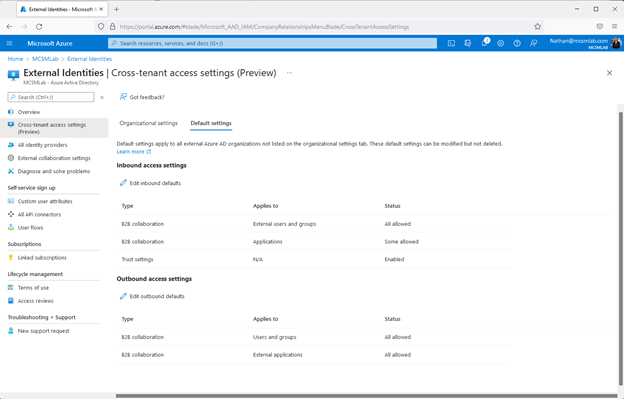
Within just this part of the instrument, you can handle the cross-tenant access configurations that use to all other Azure Advert tenants. Guest end users from other companies that are not setup with distinct settings of their own will receive their entry configurations from below.
As shown earlier mentioned, the settings are separated into inbound and outbound configurations. The inbound and outbound options are further separated into B2B collaboration for people and teams and applications. The inbound configurations also have a segment for rely on options.
The rely on options allow for you to belief the MFA setup, compliant devices, and Azure Advertisement joined equipment from other tenants. I would suggest leaving these possibilities off in this article, not permitting default believe in for external organizations stability configurations. If you’d like to rely on the MFA, criticism devices, or Azure Advert joined unit options from a different group that can be done especially for every single business less than the “organization settings” segment.
Continuing with the inbound settings for B2B collaboration. Right here you can allow or block all external access for consumers and teams or by software. “B2B collaboration inbound accessibility options allows you collaborate with people outside the house of your group by allowing for them to indicator in using their very own identites [sic]. These end users become friends in your Azure Advert business.”
The very same configurations are readily available below the Outbound obtain options. The change is these configurations handle the accessibility people from your Azure Advertisement tenant will have in other tenants. Of training course, you can’t grant your buyers obtain to any other tenant, but these options can restrict the entry you end users have in other tenants.
The apps segment permits you to modify the access environment by application as a substitute of end users or teams. You can add specific apps to this segment. I extra “Office 365 SharePoint Online” as revealed in the screenshot under:
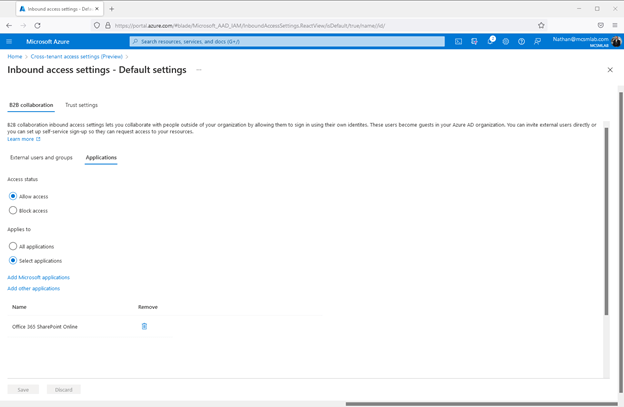
The “Allow entry/Block Access” radio button under “External people and groups” and less than “Applications” will have to the two be set to possibly enable or block. If I consider to set block access underneath applications although let accessibility is established underneath Exterior customers and groups, I get the pursuing error:

Moreover, the “Applies to” area does not allow you to permit or block certain applications independently. As the feature is at present, I do not see any explanation to muck with the “All apps/Decide on applications” radio button as the above “Allow entry/Block access” variety will implement to every thing. I never see a way to let obtain to SharePoint On line when blocking obtain to Exchange On-line. I’m likely to suppose that bit of performance will evolve. This element is nonetheless in Preview. I hope and count on that will be preset before this aspect moves to normal availability.
Going on from the default configurations to the organizational options, this part enables you to modify the default configurations for particular organizations you increase. I would endorse leaving the default configurations portion as it is for protection causes and adding particular further permissions to distinct companies below.
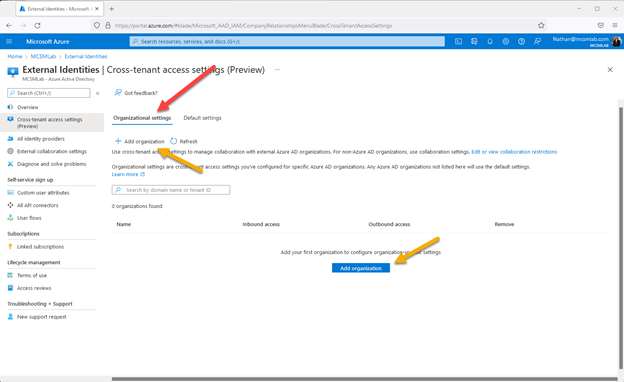
To exam this out, I spun up a examination tenant from the Microsoft Developer portal. In the screenshot above, the eco-friendly arrow point to in which you will go to increase an external business. Both equally buttons do the same factor, so I’m not sure why Microsoft put the exact button on this web site two times.
You can include a different firm right here making use of both the tenant’s name (mcsmlab.com, or mcsmlab.onmicrosoft.com both equally get the job done for my tenant), or applying the Tenant ID. The screenshot under reveals the interface where I included a test tenant to my personal tenant.
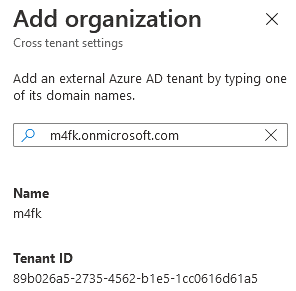
After a tenant is added right here, the cross-tenant obtain settings portal will look like this:
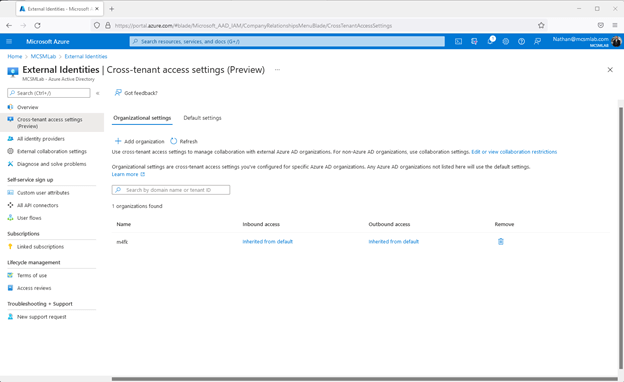
As you can see there, equally inbound and outbound options are initially established to “inherited from default”, which makes it possible for the same obtain for end users from and to that firm as if you experienced not extra that firm listed here at all. Even so, I now can personalize all the location I talked about above for this unique business. Clicking on the blue “Inherited from default” for possibly inbound or outbound access settings lets me to customize entry settings for end users from that specific Azure Advertisement tenant.
So now we’re all done correct? Buyers from the m4fk take a look at tenant should really have accessibility to all my means set up in my mcmslab tenant?
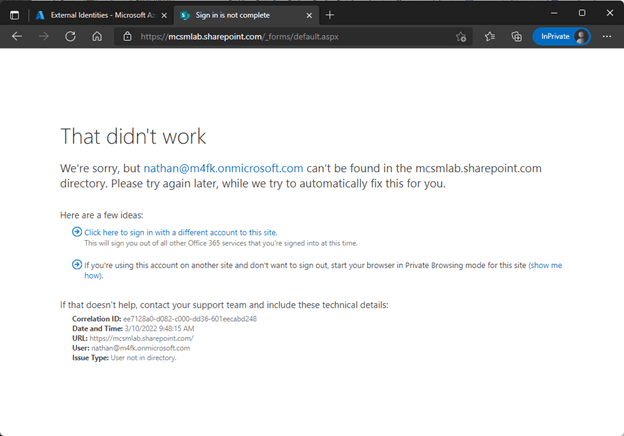
Nope.
These cross-tenant accessibility settings do govern the obtain customers from the m4fk tenant would have to methods within just my mcsmlab tenant but adding an group does not produce guest accounts.
The cross-tenant access options make it possible for you to modify the accessibility that visitor buyers from other businesses will have with their visitor accounts. Each user from the other organization will nonetheless require a guest account set up in your tenant, and permissions inside of the certain programs in your tenant they will be accessing. You can invite external end users directly or you can set up self-service indicator-up so they can request entry to your methods. That course of action is unchanged by this new functionality.
This tool enables you to promptly restrict the entry that visitor end users from other tenants will have in your tenant. It does not grant new cross-tenant features, or even make the current cross-tenant functionally work “better”. It does not give you an straightforward way to produce a new World Address List in Trade On the net that will contain people from yet another tenant, or immediately grant entry to all your SharePoint Online web-sites to buyers from an additional tenant with a pair of clicks.
Imagine of the new aspect as a way to easily and globally limit collaboration configurations in your tenant, not as a way to allow users from an additional group to work in your tenant.
Lively Directory Checking and Reporting
Active Directory is the foundation of your community, and the framework that controls obtain to the most significant means in your business. The ENow Active Listing Checking and Reporting instrument uncovers cracks in your Lively Listing that can result in a protection breach or very poor finish-person knowledge and permits you to swiftly detect and remove people that have inappropriate accessibility to privileged teams (Schema Admins, Domain Directors). Although ENow is not an auditing software program, our reports lower the total of perform demanded to go over HIPAA, SOX, and other compliance audits.
Obtain your Free of charge 14-working day trial to speed up your protection awareness and simplify your compliance audits. Contains total library of studies.

More Stories
The Convergence of Precision: A Technical Examination of Swiss Machining, CNC, and Medical Device Manufacturing
The AI Frontier: Exploring Cutting-Edge Developments in Artificial Intelligence
AI for Everyone: How Artificial Intelligence is Transforming Industries